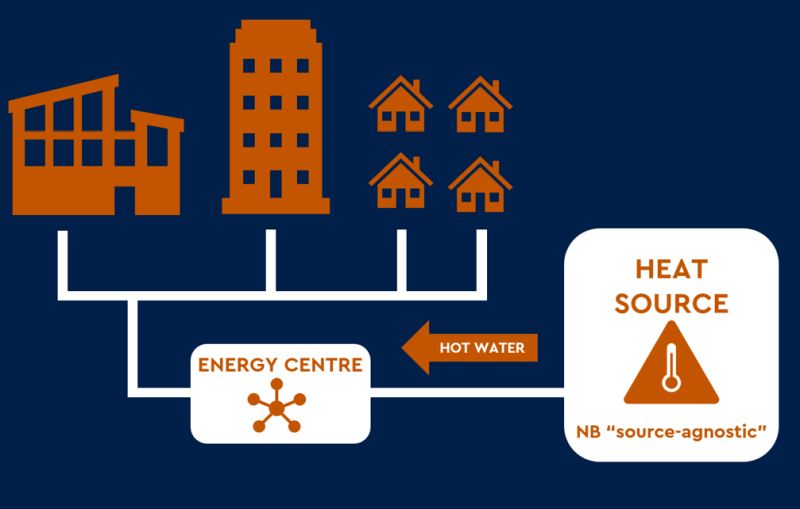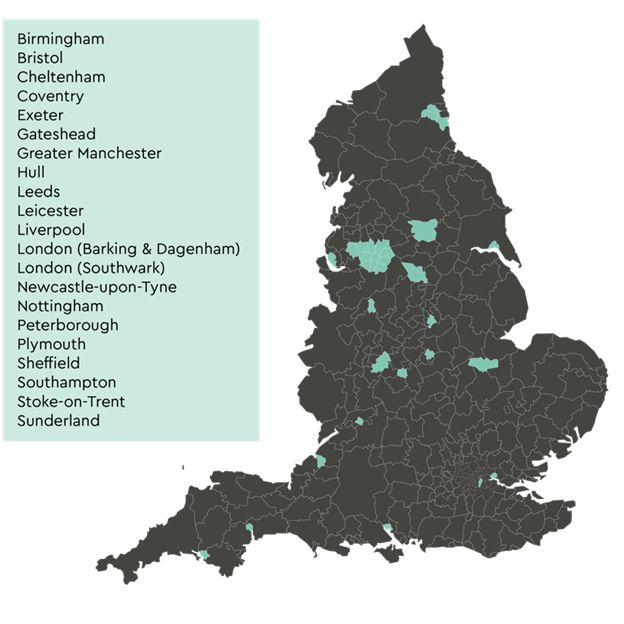- in United Kingdom
- in United Kingdom
The UK heat network market is growing fast, providing opportunities for both suppliers and property developers/owners looking for low carbon energy solutions. But what are heat networks, where are they being rolled out and how are they regulated? And what are the key issues when making contractual arrangements involving heat networks?
1 What are heat networks and how do they work?
A heat network (sometimes also referred to as "district heating") is a system of distributing heat generated from a centralised location to residential and commercial buildings through a network of insulated pipes, using heat generated from a low carbon source. They provide both heating and hot water to buildings, thereby improving energy efficiency and reducing carbon emissions.
Sources of heat
Importantly, heat networks are "source agnostic" – which means that they can take heat from a variety of different sources, such as:
- Air, ground, sea or river source heat pumps;
- Heat generated from waste e.g. incineration plants or biomass heating;
- Waste industrial or commercial heat e.g. from data centres;
- Solar thermal heat; or
- Gas-fired combined heat and power (CHP) engines – although this source is being phased out in favour of renewable energy sources.
This means that as new heat-generating technologies become available, they could be added to the sources from which the network draws its heat.

2 What is the current state of play in the UK heat network market?
Whilst heat networks currently provide approximately 3% of UK heat demand, it is estimated that they could provide up to 20% of UK heat demand by 2050 (with an investment potential of around £60 billion to £80 billion). It follows that there is a major opportunity for investors in this space.
The role of the UK Government
Although most of the funding for heat networks is expected to come from private capital, the Department of Energy Security and Net Zero (DESNZ) recognises that Government has an important role to play, particularly around:
- conferring so-called "code powers" on heat network operators, enabling them to dig up roads to lay new pipework;
- designating heat network zones, where the the Zone Coordinator can require new developments to connect to the heat network (see section 3 below); and
- creating a regulatory framework to promote consumer confidence in heat networks as a new way for consumers to obtain heat (see section 4 below).
Key milestones
- Energy Act 2023: This legislation sets out the
necessary framework for regulation, requiring heat network
operators to be authorised by the UK energy regulator Ofgem. As
explained above, heat network operators will benefit from
authorisation because they will have the same powers as other
regulated utilities such as the ability to dig up roads to build
out their networks. Existing heat network operators were deemed
authorised on 1 April 2025 and this approach will continue for any
new operators until 26 January 2027. See section 4 for more detail,
where we also outline other key obligations that will be imposed
under the new regulatory regime.
- Zoning: In October 2024, DESNZ designated six areas for the initial batch of heat network zones – in Leeds, Plymouth, Bristol, Stockport, Sheffield and London – and has provided £5.8 million in funding to support their development. It has also identified a further 14 areas for possible zoning (see section 3 for more detail).
Examples of current UK heat network projects
- Leeds: The planned network will draw heat from a nearby glass factory. Procurement is expected to launch in July 2025. Value is estimated at £3 billion, over a 50-year term.
- Plymouth: Several schemes are planned with heat sources including the Devonport Energy from Waste Plant and an NHS medical waste incinerator. Procurement is already underway. Value has been estimated at £4.2 billion, over a 60-year term.
- Old Oak and Park Royal (London): This scheme will draw waste heat from data centre cooling systems. Hemiko has been appointed as the development partner for the network, expected to serve over 9,000 new homes and businesses, with potential to expand (25,000 additional homes are expected to be built in the area by 2040). Investment by 2040 is expected to be approximately £600 million.
3 What is heat network zoning and where will the zones be located?
The Government describes a heat network zone as "a formally designated geographical area....where heat networks are expected to provide the lowest-cost solution for decarbonising heating."
Obligation on buildings within zones to connect to heat network
For heat network operators, the key benefit of being within a designated zone is the power of the Zone Coordinator (typically the local authority) to require certain buildings within the zone to connect to the heat network (see below for more detail). This should give investors greater certainty about the number of likely network connections.
For property developers and owners, an obligation to connect to a heat network may initially seem like an unwelcome restriction on their freedom of choice. However, it is expected that for many, heat networks will provide an attractive and low cost solution to the need to decarbonise heating, particularly for new developments facing more stringent energy efficiency requirements.
Other benefits of heat network zones
Other advantages of zoning (from which both operators and property owners/developers stand to benefit) include:
- Enhancing energy efficiency: Concentrating
heat network projects can improve overall energy efficiency and
reduce carbon emissions significantly for consumers and
businesses.
- Targeting investment: Directing resources and investments to specific zones ensures optimal infrastructure support and integration.
Who will heat network zoning affect?
- Developers: will need to account for zoning requirements in their project planning and potentially invest in heat network infrastructure.
- Local Authorities: will be responsible for overseeing zoning implementation and ensuring compliance.
- Landlords: may be required to modify existing heating systems in rental properties to comply with zoning mandates and connect to heat networks.
- End users: residential and commercial end-users may be required to connect to heat networks, impacting their choice of heating systems.
Which buildings will be required to connect?
Zone Coordinators may require developments receiving planning permission after designation of the zone to connect to a heat network before completion. New buildings not mandated to connect must nevertheless be "heat network ready" (so connection is feasible) and may be required to connect at a later stage (e.g. once the heat network operator has built out its network further).
Existing buildings can also be required to connect, subject to the heat network operator building out its network sufficiently and any relevant exemptions. For example, buildings may be exempt where it would not be cost-effective to connect to a heat network or where a better low carbon solution exists.
Potential zones
Currently, DESNZ is proposing heat network zones in the following locations, but it is expected that more zones will follow:

For information on the precise locations of the zones, please visit the Heat network zoning maps page on the Government website. For information on zoning outside England, see these pages dealing with the position in Scotland, Wales and Northern Ireland.
4 How are heat networks regulated and what does this mean for network operators and owners, occupiers and developers of buildings?
Historically, heat networks have not been regulated in the same way as other utility providers. The Energy Act 2023 provides for heat networks to be regulated by UK energy regulator Ofgem, placing them on a broadly similar footing to other regulated utility providers. It also aims to address consumer protection concerns over the fact that residential customers will not generally have a choice to obtain their heat and hot water from elsewhere (and cannot therefore switch away from the heat network provider if they are dissatisfied with costs or service levels). They also face a risk from failure of the heat network operator, as it is likely to be difficult to find a replacement provider of heat and hot water at short notice. Entities involved in the supply of heat and hot water via networks will therefore be required to:
- comply with consumer protection obligations relating to pricing and billing, performance standards and compensation, unbundling of the service charge from heat supply (so consumers can easily see how much their heating/hot water is costing) and treatment of vulnerable consumers, such as the elderly or disabled;
- draw up contingency plans designed to ensure continuity of supply in the event of network failure or operator insolvency and keep these under review; and
- comply with various reporting obligations designed to enable Ofgem to monitor compliance with the above obligations and check that entities involved in heat networks remain on a sound financial footing.
Who will be regulated?
Unsurprisingly, heat network operators will be regulated – but landlords could also be subject to heat network regulatory obligations, even where they are not directly responsible for operating the heat network. This is because the regulations apply to both "operators" and "suppliers", with the latter being defined as the entity that holds the contract with customers. For example, if a lease includes the provision of heat and hot water via a heat network, the landlord may fall within scope. By contrast, where an energy services company (commonly referred to as an "ESCO") is appointed and contracts directly with customers, the landlord is unlikely to fall within scope. Given the extent of the regulatory obligations, many landlords are therefore likely to prefer arrangements where the heat network operator contracts directly with occupiers – and developers will want to bear this in mind when structuring their arrangements (see section 5), prior to disposing of the property to a landlord.
Timeline for introducing heat network regulation
Ofgem will not begin regulating the sector until January 2026, when most of its authorisation conditions will start to take effect. All regulations are planned to be in place and enforced from January 2027.

Existing heat network operators will benefit from "deemed authorisation" and this approach will continue for any new operators until 26 January 2027. After that, new operators will need to apply to Ofgem for authorisation.
5 What contractual arrangements are needed to facilitate heat networks?
Contractual arrangements for heat networks can be complex, particularly given the regulatory background (see above). They will typically need to address the following:
- Construction and Maintenance of Infrastructure: Agreements between developers and heat network operators will need to set out each party's responsibilities for construction and ongoing maintenance.
- Supply Contracts: These contracts set out the terms of heat supply to customers (commercial or residential), including pricing structures, service standards and dispute resolution mechanisms.
- Licensing and Compliance: Landlords and operators must have the necessary licences and adhere to the incoming regulatory requirements, such as safety standards, efficiency goals and consumer protection measures.
Heat Network Agreements
When establishing a heat network, various contractual arrangements are required. These agreements typically define responsibilities and terms between developers, operators, landlords and customers (commercial or residential) in respect of the installation, connection, operation and maintenance of the heat network and the supply of heat. Key types of agreements include:
- Concession Agreements: A concession involves outsourcing the operation and maintenance of heat networks to an ESCO. These contracts typically include provisions for connection fees, infrastructure requirements, timelines and performance guarantees, ensuring that the heat network operates efficiently and meets agreed service levels.
- Direct Supply Contracts: For licensed operators, establishing direct agreements with consumers or businesses within the concession or zoned areas to ensure consistent and compliant supply of heat. These contracts would include detailed terms regarding pricing, service quality and maintenance responsibilities.
6 How we can help
Travers Smith offers a comprehensive approach to navigating the complexities of heat networks:
- Dedicated Commercial Team: Our experts can guide you through regulatory compliance, zoning requirements and the integration of heat networks into your development projects. We also work closely with experts from our Real Estate, Planning and Construction teams.
- Contract Negotiation and Drafting: We have considerable experience in drafting and negotiating robust and fair contractual arrangements with all stakeholders, including ESCO contracts, construction agreements, leases and supply agreements, and advertising on planning and regulatory requirements.
- Legal and Strategic Advice: We leverage our extensive experience to optimise your business strategy, whether implementing new heat networks or expanding existing ones.
Our combined expertise ensures your project is not only legally compliant but strategically positioned to benefit from the evolving regulatory landscape. Contact us today to learn how we can support your initiatives in the heat network sector.
The content of this article is intended to provide a general guide to the subject matter. Specialist advice should be sought about your specific circumstances.






